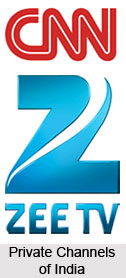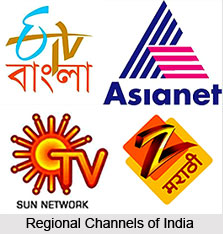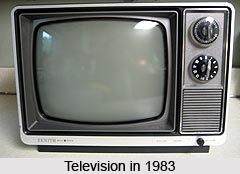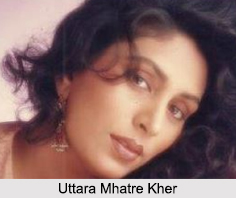 Private Television in India infiltrated into the Indian boundaries with channels like CNN, Star Plus and Zee TV in 1990s which marked a break in the monopoly of Doordarshan. Private television in India strictly aimed at entertaining the viewers to its full extent. In the early years of 1990s, the private channels offered only entertainment programmes, which included family drama, comedy serials, children programmes, cartoons, movies, talk shows, recipe shows, musical concerts, non-fiction programmes and so on. Presently, the private television industry has more specific viewers. In this competitive market, channels are targeting specific viewers. News channels attract more viewers beyond their target by producing interactive and interesting programmes. Every private channel does an extensive research on different concepts and different themes to attract more viewers and in the same time more advertisers. With increased consumer preference for news programmes, private television news channels have grown faster than other channels.
Private Television in India infiltrated into the Indian boundaries with channels like CNN, Star Plus and Zee TV in 1990s which marked a break in the monopoly of Doordarshan. Private television in India strictly aimed at entertaining the viewers to its full extent. In the early years of 1990s, the private channels offered only entertainment programmes, which included family drama, comedy serials, children programmes, cartoons, movies, talk shows, recipe shows, musical concerts, non-fiction programmes and so on. Presently, the private television industry has more specific viewers. In this competitive market, channels are targeting specific viewers. News channels attract more viewers beyond their target by producing interactive and interesting programmes. Every private channel does an extensive research on different concepts and different themes to attract more viewers and in the same time more advertisers. With increased consumer preference for news programmes, private television news channels have grown faster than other channels.
Emergence of Private Television in India
The mid-1980s saw the rising popularity of television serials like Hum Log which was broadcasted on Doordarshan. This also triggered an increase in the purchase of television sets and created a need for changes in the nature of television programming. Thus, a niche market for alternative entertainment fare was created, and small time cable television entrepreneurs fulfilled this need for the urban public in India. Private television began in Maharashtra and Gujarat in the mid-1980s through the efforts of private entrepreneurs, who wired apartment buildings and charged a monthly subscription fee to transmit films and serials through a central video-playing unit. Cable services took off in popularity throughout the nation in 1991-92 with the accessibility of foreign satellite channels. Only the government-controlled television system Doordarshan, however, was allowed to broadcast from the central unit of India. At the time of the Gulf War, a private, Hong Kong-based television network, STAR-TV, began growing, BBC and other news programs were introduced in India via satellite in 1991. A vast cadre of cable television operators purchased satellite dishes and wired apartment buildings or urban neighbourhoods. Because the private networks were up-linking their satellite signals from Hong Kong, Singapore, or other foreign sites, they were actually not violating the government regulations that gave Doordarshan a monopoly over broadcasting from Indian soil.
Evolution of Private Television in India
 By 2000, more than 40 private television networks were broadcasting in India, including private networks like STAR-TV, Zee-TV, SONY, CNN, BBC and many others. The programming comprised Western entertainment imports and also Indian-produced serials, talk shows, game shows and news and current affairs. These private television programs have greatly multiplied the choices that were available to Indian audiences. Coupled with the New Economic Policy in the 1990s, and the accompanying invasion of the Indian market by American and other foreign companies, private television has brought about many important social changes.
By 2000, more than 40 private television networks were broadcasting in India, including private networks like STAR-TV, Zee-TV, SONY, CNN, BBC and many others. The programming comprised Western entertainment imports and also Indian-produced serials, talk shows, game shows and news and current affairs. These private television programs have greatly multiplied the choices that were available to Indian audiences. Coupled with the New Economic Policy in the 1990s, and the accompanying invasion of the Indian market by American and other foreign companies, private television has brought about many important social changes.
Inflation of Private Television in India
While Doordarshan was expanding rapidly in the 1980s throughout the nation, the cable television industry was mushrooming in the major Indian cities. The VCR greatly created a number of entertainment options for Indian audiences, providing alternatives to Doordarshan`s single-channel programming. Video viewing at home and in community-based video parlours increased rapidly. The video series consisted mostly of film-based entertainment, both domestic and imported. By 1984, entrepreneurs in cities such as Mumbai and Ahmedabad had continually wired the apartment buildings to transmit several films a day. Within a few years, this phenomenon became widespread in other urban centres as well. The number of cable operators in India exploded from about 100 in 1984 to 1,200 in 1988, 15,000 in 1992, and to about 60,000 in 1999.
The Gulf War of 1991 actually popularised CNN and also launched the STAR-TV in that same year by the Whampoa Hutchison Group of Hong Kong, signalled the arrival of private satellite channels in India. STAR-TV, broadcast through the Chinese satellite ASIASAT 1, offered five 24-hour channels in 38 countries of Asia. In 1992, Zee-TV, a Hindi-based satellite entertainment channel, began airing programs to cable television systems in India. Many cable operators installed large satellite dishes to receive these private satellite channels, and offered them to cable subscribers, greatly multiplying the entertainment options in India. By 1995, over 12 million Indian households were watching private television and satellite channels; by 2000, this number had risen to more than 35 million. Over 40 private cable and satellite channels were available to Indian audiences, including several that focused exclusively on regional-language broadcasting like Eenadu -TV, Sun -TV, Raj -TV, Udaya -TV, and Asianet. By 2000, Zee-TV also aired several regional networks, broadcasting in Marathi, Bengali and other languages.
Private Television in Contemporary India
 The nature of Indian private television gradually changed in a very significant and dramatic way. Indian television suddenly became much more entertainment-driven, like the Hollywood-produced television series in America. Western programs and Indian-produced programs that transmitted consumerist and material values predominated on the new private television channels. The new television atmosphere was made possible by satellite and cable technology. A host of private television networks like STAR-TV, Zee-TV, SONY, and MTV began broadcasting in different parts of India. Even the relatively demure Doordarshan was forced to change its programming curriculum in order to retain its prevailing market share and its advertising revenues. But the private networks dominated among the urban elite audiences in India, the market chiefly desired by advertisers because it yields more advertising income per rating point. Urban elites have the expandable income with which to purchase the products and services advertised on television; these people possess the ideal demographics that are desired by television advertisers. In contemporary India, private television has acquired a phenomenal space of entertainment. The leading private channels in India include BBC, Star Plus, Sony Entertainment Television, Zee TV, MTV and Discovery Channel. The privatised channels are booming immensely.
The nature of Indian private television gradually changed in a very significant and dramatic way. Indian television suddenly became much more entertainment-driven, like the Hollywood-produced television series in America. Western programs and Indian-produced programs that transmitted consumerist and material values predominated on the new private television channels. The new television atmosphere was made possible by satellite and cable technology. A host of private television networks like STAR-TV, Zee-TV, SONY, and MTV began broadcasting in different parts of India. Even the relatively demure Doordarshan was forced to change its programming curriculum in order to retain its prevailing market share and its advertising revenues. But the private networks dominated among the urban elite audiences in India, the market chiefly desired by advertisers because it yields more advertising income per rating point. Urban elites have the expandable income with which to purchase the products and services advertised on television; these people possess the ideal demographics that are desired by television advertisers. In contemporary India, private television has acquired a phenomenal space of entertainment. The leading private channels in India include BBC, Star Plus, Sony Entertainment Television, Zee TV, MTV and Discovery Channel. The privatised channels are booming immensely.





